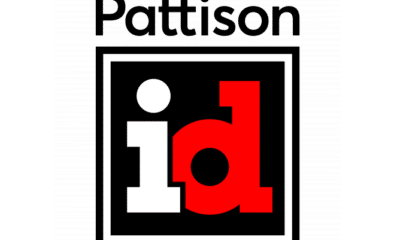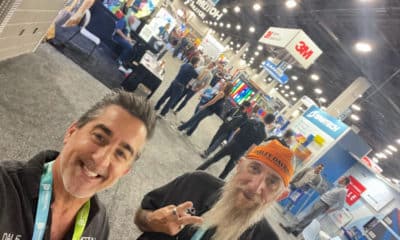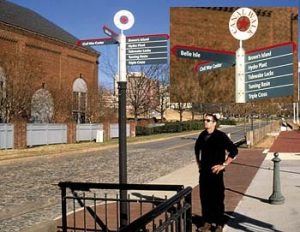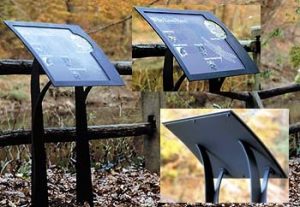Jerome Cloud is the design principal of Thinkframe, the newly merged Philadelphia design firm which married his prior firm, Cloud and Gehshan Assoc., where he served as design principal since its 1987 inception, with Kelsh Wilson Design. He has won several awards for his work in environmental and identity design, architectural signage and marketing communications. He earned his design degree from the University of the Arts in Philadelphia and is currently a candidate for a master’s degree from New York-based Pratt Institute School of Design Management.
Cloud is also a founding member of the American Institute of Graphic Arts’ (AIGA) Philadelphia chapter and was co-chair of the AIGA/ Philadelphia Design Show 3. He has lectured at meetings of Preservation Pennsylvania and Scenic America and has instructed at the University of the Arts, Drexel University and the University of Philadelphia. Further, he is a member of the American Center for Design, International Downtown Assn., Design Management Institute and Waterfront Center.
Cloud commends Dick Felton as his greatest mentor. Felton was a designer at New York-based Anspaugh, Grossman and Portugal (currently AG Enterprises), as well as an instructor at the University of Fine Arts.
He influenced me by showing me new ways to work, instilling in me the discipline to approach design in an analytical, methodical manner,” Cloud notes.
Joining forces
Throughout my 14 years in the industry, I’ve continued to remain committed to asking the right questions. Looking at clients’ goals and missions in an objective manner — and not predetermining what you think they would want — is paramount to establishing good design. This collaborative effort usually yields some type of discovery and invention.
We took a similar approach in our merger to become Thinkframe. We chose the name Thinkframe because we believe merging the two words has the meaning “intelligence made visible.” Names are not just handy labels — they also provide context, connotations and connections with our clients. It’s concise, descriptive, memorable, and, last but not least, the Internet address was available.
Because we have a broad range of disciplines within the firm, we can create design solutions across several media. Our staff includes industrial, graphic and environmental designers, as well as writers and photographers. We share the common goal of discovering what is special about a place, and then communicating those qualities with clarity and exuberance.
A stroll through Old Richmond
In 1998, the city of Richmond, VA, retained our firm to develop a signage and identity program for its riverfront area. The city has invested roughly $40 million to develop a two-mile area of the canal along the James River into the Richmond Riverfront Canal Walk. From colonial times to the present, the canal has been the heart of Richmond’s commerce and culture. The city, along with substantial private funds invested in retail, hotel, office and residential development, sought to pay homage to the river’s vital role in civic history.
We were presented the opportunity to design a comprehensive system that would integrate gateway elements, banners, kiosks and directional signage, as well as building and map identification.
Ralph Applebaum and Assoc. (New York) designed the canal’s exhibit elements, with Wallace, Roberts and Todd developing the landscaping, constructing pedestrian bridges and installing walkways, lighting and street furniture. For the exhibits, which recount Richmond’s voluminous Civil War history, we designed walkway signage and wayfinding solutions.
The Canal district is unique because it’s a fusion of genteel Georgian-style residences and factories, bridges and warehouses of the post-Civil War era. So that the signs reflect a mixture of these refined and muscular tones, we used fluted columns for the legs to connote a residential feel, with an upper portion of cruciform structures made of grommeted angle iron, im-parting a more industrial quality. The logo derives from an early city seal.
The second phase of the project includes gateway signage that guides visitors to points of entry, as well as mapping and building identification programs.
Winterthur
Our firm also earned the opportunity to develop an exterior sign system for the Winterthur Museum (Kennett Square, PA). The museum, which also features a garden and library, was once the estate of chemical magnate Henry Francis du Pont. The museum houses one of the world’s finest collections of early American decorative arts. The museum entertains approximately 200,000 visitors annually, and needed adequate wayfinding for tour buses, vehicles and pedestrians.
In addition to providing identity and directional solutions, we sought to communicate a sense of place and reflection of the institution. The sign-age system that existed beforehand was very corporate and sterile, with the feel of a naval base.
Because the museum has a very beautiful, rolling landscape, we wanted to develop a program consistent with the environment. We chose a dark-blue color scheme that provides a warm, personable feel, yet is not too assertive for its surroundings. The comprehensive system of about 15 different sign types will be installed this spring.
Visitors will be greeted by a 5 x 12 ft., 10-in. entry sign and changeable-message board that notifies them of upcoming events. Additional signage — including street signs, gate markings and directional signage — are aluminum sheet panels atop extruded aluminum posts.
The call of the wild
Prior to the merger, Cloud and Gehshan developed wayfinding and interpretive signage for the Tyler Arboretum, a 700-acre “living” museum near Philadelphia with hiking trails and idyllic bird-watching habitats.
The property, originally granted for public use by William Penn, served as a functioning arboretum in the mid-1800s. The Minshall family has owned the land since 1682.
We hired interpretive specialist Paxton Barnes from the Bronx Zoo to assist in the design of the panels. The team conducted workshops and brought together several emerging themes, including botany and history.
The result was a comprehensive sign system with 40 panels made of powder-coated, black aluminum. The design process included testing prototypes and interpretive content, with the goal of creating a unified experience that gave visitors an understanding of the natural world.
Thinkframe believes that signage and related environmental enhance-ments (e.g. gateways, kiosks and banners) are powerful tools for establishing a sense of place. Our collective job is to plan programs that create an exciting presence without clutter. The civic art we create is an effort to honor and embellish the public realm with communicative design that makes public spaces more pleasurable and educational.


 Real Deal2 weeks ago
Real Deal2 weeks ago
 Projects2 weeks ago
Projects2 weeks ago
 Projects2 days ago
Projects2 days ago
 News3 days ago
News3 days ago
 Business Management1 week ago
Business Management1 week ago
 News2 weeks ago
News2 weeks ago
 Manager's To Do1 week ago
Manager's To Do1 week ago
 Dale Salamacha1 week ago
Dale Salamacha1 week ago














